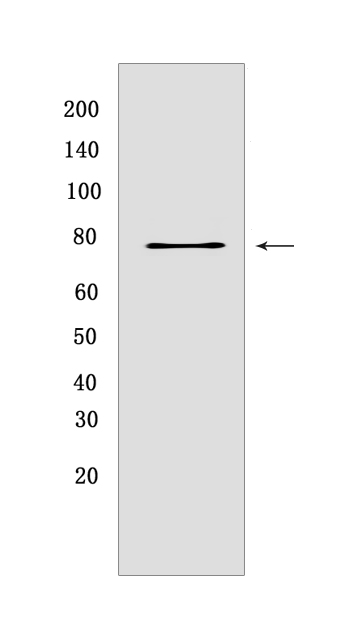Phospho-RIP (Ser321) Rabbit mAb[I6O6]Cat NO.: A21292
Western blot(SDS PAGE) analysis of extracts from C2C12 cells,treated with mTNF-α (20 ng/ml,5min)..Using Phospho-RIP (Ser321) Rabbit mAb IgG [I6O6] at dilution of 1:1000 incubated at 4℃ over night.
Product information
Protein names :Ripk1,Rinp,Rip,RIPK1_MOUSE,Receptor-interacting serine/threonine-protein kinase 1
UniProtID :Q60855
MW(kDa) : 78
Form :Liquid
Purification :Protein A purification
Host :Rabbit
Isotype :IgG
sensitivity :Endogenous
Reactivity :Mouse
- ApplicationDilution
- 免疫印迹(WB)1:1000-2000
- The optimal dilutions should be determined by the end user
Specificity :Antibody is produced by immunizing animals with a synthetic peptide corresponding to residues surrounding Ser321 of Mouse RIP
Storage :Antibody store in 10 mM PBS, 0.5mg/ml BSA, 50% glycerol. Shipped at 4°C. Store at-20°C or -80°C. Products are valid for one natural year of receipt.Avoid repeated freeze / thaw cycles.
WB Positive detected :C2C12 cells,treated with mTNF-α (20 ng/ml,5min).
Function : Serine-threonine kinase which is a key regulator of TNF-mediated apoptosis, necroptosis and inflammatory pathways (PubMed:24813849, PubMed:24813850, PubMed:24557836, PubMed:27819681, PubMed:28842570, PubMed:31511692, PubMed:31827280, PubMed:31827281, PubMed:33397971). Exhibits kinase activity-dependent functions that regulate cell death and kinase-independent scaffold functions regulating inflammatory signaling and cell survival (PubMed:24813849, PubMed:24813850, PubMed:24557836, PubMed:28842570, PubMed:31519886, PubMed:31519887). Has kinase-independent scaffold functions: upon binding of TNF to TNFR1, RIPK1 is recruited to the TNF-R1 signaling complex (TNF-RSC also known as complex I) where it acts as a scaffold protein promoting cell survival, in part, by activating the canonical NF-kappa-B pathway (PubMed:31519886, PubMed:31519887). Kinase activity is essential to regulate necroptosis and apoptosis, two parallel forms of cell death: upon activation of its protein kinase activity, regulates assembly of two death-inducing complexes, namely complex IIa (RIPK1-FADD-CASP8), which drives apoptosis, and the complex IIb (RIPK1-RIPK3-MLKL), which drives necroptosis (PubMed:28842570, PubMed:27819681, PubMed:27819682, PubMed:29440439, PubMed:30988283, PubMed:31519886, PubMed:31519887). RIPK1 is required to limit CASP8-dependent TNFR1-induced apoptosis (PubMed:24813849, PubMed:24813850, PubMed:24557836). In normal conditions, RIPK1 acts as an inhibitor of RIPK3-dependent necroptosis, a process mediated by RIPK3 component of complex IIb, which catalyzes phosphorylation of MLKL upon induction by ZBP1 (PubMed:24557836, PubMed:27819681, PubMed:27819682, PubMed:31358656). Inhibits RIPK3-mediated necroptosis via FADD-mediated recruitment of CASP8, which cleaves RIPK1 and limits TNF-induced necroptosis (PubMed:31358656). Required to inhibit apoptosis and necroptosis during embryonic development: acts by preventing the interaction of TRADD with FADD thereby limiting aberrant activation of CASP8 (PubMed:30867408, PubMed:30185824). In addition to apoptosis and necroptosis, also involved in inflammatory response by promoting transcriptional production of pro-inflammatory cytokines, such as interleukin-6 (IL6) (PubMed:31827280, PubMed:31827281). Phosphorylates RIPK3: RIPK1 and RIPK3 undergo reciprocal auto- and trans-phosphorylation (By similarity). Phosphorylates DAB2IP at 'Ser-728' in a TNF-alpha-dependent manner, and thereby activates the MAP3K5-JNK apoptotic cascade (By similarity). Required for ZBP1-induced NF-kappa-B activation in response to DNA damage (PubMed:12654725, PubMed:19590578)..
Tissue specificity :Found at low levels in all tissues..
Subcellular locationi :Cytoplasm. Cell membrane.
IMPORTANT: For western blots, incubate membrane with diluted primary antibody in 1% w/v BSA, 1X TBST at 4°C overnight.


